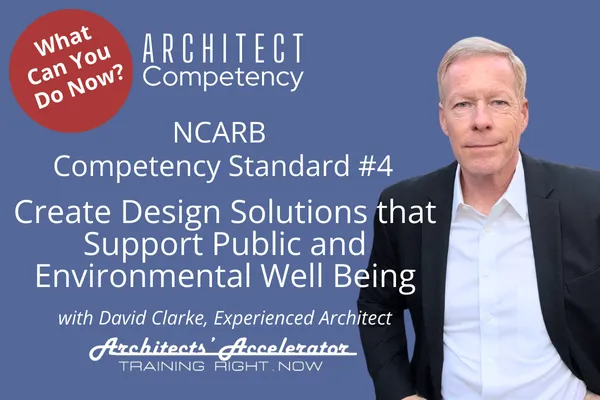
NCARB Competency Standard #4: Create Design Solutions that Support Public and Environmental Well Being
This competency and the next two cover the knowledge and skills most people associate with Architects – Design.
Architects have a responsibility to protect the health, safety and welfare of people, not only in our buildings, but around our buildings and being safe in the environments we create NCARB has tied into this criteria the whole environmental and sustainability component, because we also are stewards of our environment.
NCARB Competency Standard #4: Create Design Solutions that Support Public and Environmental Well Being
At the point of initial licensure, architects with this competency can …
• Implement design strategies that minimize environmental impact, safeguard environmental sustainability, ensure longevity and durability of projects, and adapt to evolving environmental and societal conditions.
• Implement design strategies that support the health, safety, and welfare of building occupants and the neighboring community.
• Advise clients and consultants regarding the sustainability and resiliency of design options in accordance with relevant codes, regulations, ratings, industry standards, and technical information.
What can you do right now?
While the key verb in the competency – what you are to do – is create design solutions, the bullet points involve implementing design strategies.
When you're first starting out as a new design professional, you are not likely to get to do the designing. Your firm probably has broadly experienced architects who are assigned to design.
The fact that the competency details focus on implementation of design is a big advantage for you. You don't have to have that responsibility to take that on right away, but when you implement design strategies in a project, you get this experience.
When you have the experience of implementing it, you learn more about it, and then when it is your turn, you can create it. Implementing design strategies that support health, safety and welfare building occupants and the neighboring community is a basic responsibility of the architect.
We make sure that our buildings are code compliant or better, and we make sure that the construction is sufficiently sound to protect people.
In order to advise clients and consultants regarding sustainability and resiliency of design options in accordance with relevant codes, regulations, ratings, industry standards and technical information, you need to learn about those codes and requirements first.
Continue to study.
Continue to learn about advanced technologies and advanced understandings of what environmentalism is and how it's implemented in architecture. When it's time to talk to your clients, you can be well informed.
